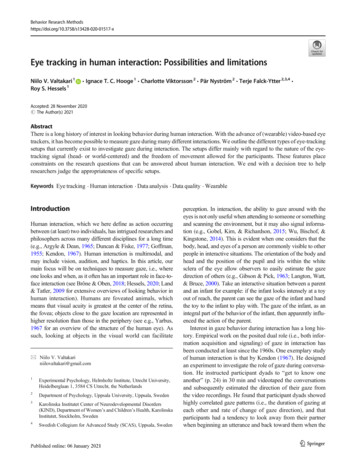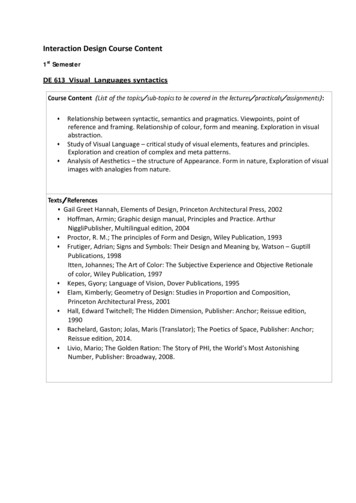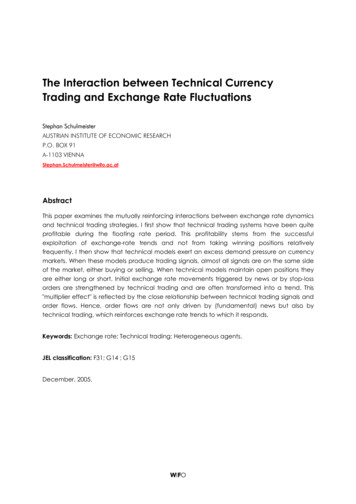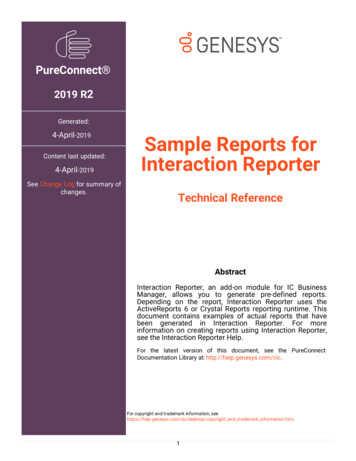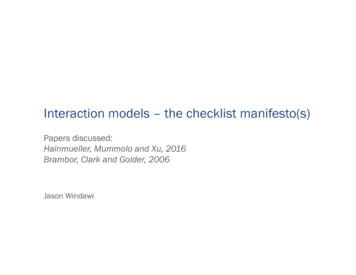
Transcription
Interaction models – the checklist manifesto(s)Papers discussed:Hainmueller, Mummolo and Xu, 2016Brambor, Clark and Golder, 2006Jason Windawi
Interactions in linear modelsA way of measuring the conditional effect of context on therelationship between a focal independent variable and anoutcome– How does the effect of treatment D on outcome Y vary givenmoderator X?1
“State of the art” – Brambor, Clark and Golder (2006)A checklist for empirical analysis using linear interaction models:1. Include all constitutive terms2. Don’t interpret constitutive terms/coefficients as unconditionalmarginal effects3. Calculate and plot substantively meaningful marginal effects andstandard errors2
Sociology? Breznau (2015) vs. Brooks & Manza (2006)LiberalDemocracy?3
Hainmueller et al. (2016)Two problems with the literature post-Brambor:1. Failure to meet assumptions of a linear interaction effect(LIE)2. Potential lack of common support (for both treatment Dand moderator X) necessary4
New checklist!Hainmueller et al. recommend adding the followingdiagnostics to the Brambor checklist:1. Scatterplots2. Binning estimator3. Kernel estimator5
Simulated data,6
Diagnostic 1: Binary Treatment (D)SEPARATION/HETEROGENEITY Divide data into cases bytreatmentLINEARITY Does the distribu4on of resultsindicate a linear rela4onship?LOESS (red) vs. regression(blue)SUPPORT Is there sufficient commonsupport?Box plot of distribu:on of X7
Diagnostic 1: Continuous Treatment (D)SEPARATION/HETEROGENEITY Divide data into three bins bymoderatorLINEARITY?SUPPORT?8
Alternative Diagnostic 1: Generalized Additive Model9
Diagnostic 2: Binning Estimator1Separate con4nuous moderator X into bins (recommend 3)2Establish evalua4on points xj , j 1, 2, 33Es4mate coefficients using evalua4on points4Plot all the things (new checklist)10
Diagnostic 2: Plotting the Binning EstimatorStart with output from standard linear interac4on model per Brambor et al .add graphic toshow support for X11
Diagnostic 2: Plotting the Binning Estimator .add es4mates ofαj at xj with 95% CIsWhy? For bin es4mator:X xj ME(xj) αj12
Diagnostic 2: Simulation results13
Diagnostic 3: Kernel estimator Draws on Li and Racine (2010)’s semi-parametric, variablecoefficient model– Designed to accommodate both dichotomous and continuousvariables– Designed to capture variation in coefficient(s) of interest whileaddress shortcomings of approaches relying on separation/binning14
Diagnostic 3: Kernel estimatorAssumed ModelKernelĝ(x0 ) âD - β̂ D(0) âD â(x0 ) Y(x0 ) â D15
Diagnostic 3: Kernel estimatorGraphing â(x0 ) across support of X16
Problem replication: lack of common support** Chapman (2009)17
Problem replication: lack of common support** Chapman (2009)18
Widespread problems19
How widespread? A scoring systemFour possible points, one each for: Reject equality of marginal effects (αj) for low and high bins No severe interpolation or extrapolation (includes L-kurtosishurdle) Monotonic Fail to reject linear model in Wald test vs. binned20
Scoring eSample: 55 replica:ons from 22 papers in leading Poli:cs journals21
Interaction models – the checklist manifesto(s) Papers discussed: Hainmueller, Mummolo and Xu, 2016 Brambor, Clark and Golder, 2006 Jason Windawi . Interactions in linear models 1 A way of measuring the conditional effect of context on the






